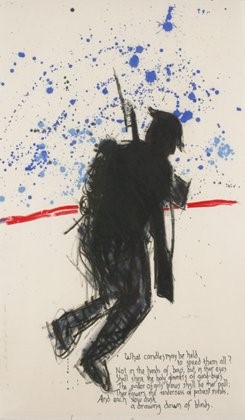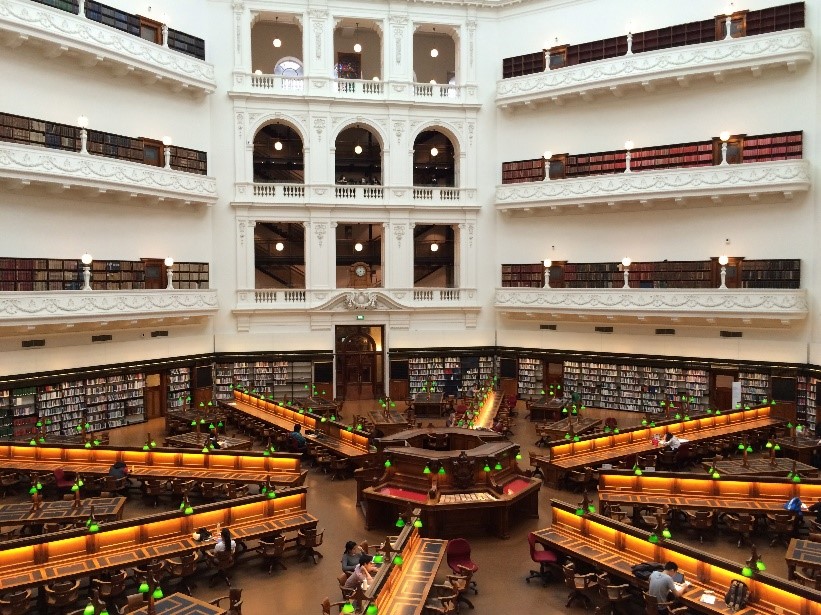HTAV News
Remember, Research Reflect: Victorian Stories of the First World War
21 Jan 15
A special event by the Shrine of Remembrance, State Library of Victoria, Melbourne Museum and HTAV.
On Friday, 5 December 2014, the inaugural ‘Remember, Research, Reflect’ collaborative experience took place. This new initiative from the Shrine of Remembrance, State Library of Victoria, Museum Victoria and HTAV is aimed at enriching the experience of the World War I centenary through personal stories. The program provided attendees with the unique opportunity to experience programs and exhibits at all three public institutions. The educational possibilities demonstrated throughout the day were rich and inspiring. Below follows a reflection of the day:
Attendees gathered in the newly-opened Education Centre at the Shrine of Remembrance. It is a stunning facility, built deep into the earth, the pyramidal roof looming above. Upon arrival we learnt that the unusual, patterned colouring of the concrete in the entrance replicates the camouflage on Australia’s WWI naval ships. The display of poppies that welcome visitors to the Centre mark out the Ode of Remembrance in Morse code. The wall itself represents an elongated map of the world. What appears to be a red and black shade canopy forms into the shape of poppy when viewed from above.
During the first session, each speaker outlined different methods of engaging students with history through personal stories. Dr Rosalie Triolo (Monash University) began by asking attendees, ‘What’s the most boring history?’ She then directed the crowd towards an image of a school group from Perth State School, Tasmania in 1916 (see below). Triolo singled out four particular children from the same family. By that stage in 1916, they had lost one brother to the war. By 1918, they had lost a second. What appeared to be a standard school photograph swiftly acquired greater depth under Triolo’s empathetic questioning. ‘How did this school community comes to terms with grief?’ she prompted. ‘With the loss of lives? The return of their family, friends and colleagues, injured and invalided? What of the eligible male teachers who did not enlist? What pressure did they feel? Why did they not go?’ Triolo concluded by revealing that one of the students was her grandmother, and that this very photo had sparked her interest in the history of school communities and the impact of war. By the end of the presentation it was clear why Triolo’s initial question was intended: there is no boring history once you start looking for the personal stories.
![[Text Box: (Photo courtesy of DVA)] [Perth State School, Tasmania 1916.]](/sb_cache/htavnews/id/19/f/RRR1.jpg)
Sandy Phillips (Department of Education and Training) followed with a quick-fire overview of the use of digital technologies in the history classroom emphasising the integrative nature of ICT, and its importance for deep learning about WWI. Camperdown teacher Lachie Lee shared a sample exercise from his Year 12 history classroom, where he inspires deep questioning and inquiry amongst students by examining a photograph of six diggers. One of the men was Lee’s grandfather, who he remembers fondly as a ‘grumpy old man’. Students learn that three of the six men were killed on their first day of combat, and that Lee’s own grandfather re-enlisted in World War II despite being discharged for ‘cerebral malaria’ - a malady Lee suspects was a common ‘alias’ for shell-shock. Richard Smith (HTAV) concluded the session by outlining the numerous opportunities available to teachers to engage students through history competitions. Smith demonstrated ‘historical inquiry at its best’ was on show in many student entries, and that the entries that explored personal stories often stood out the most.
The panel concluded and attendees were treated to a tour of the newly opened Galleries of Remembrance. Our guide, Peter Hough, stressed that the Shrine is primarily a memorial, and that the galleries are designed to supplement the memorialisation of the fallen.
I admit to becoming quickly lost amongst the imposing columns of the Shrine. I found myself mesmerised standing before a large Union Jack scrawled with names. A plaque read ‘Changi Flag’. I was treated to a remarkable history of the flag by a volunteer guide. The flag had somehow remained hidden throughout the course of the war, and had been signed by over 100 Australian POWs in Changi.
The galleries contained a thoughtful collection. I particularly loved the ‘Everyman’ exhibit, a series of drawings inspired by the poetry of Wilfred Owen (see below). I took a moment of reprieve from the group to wander amongst the dark, towering columns of the Shrine, draped in simple but deeply evocative images that complemented the penetrating words of Owen. There in the dark, deep below the earth, I was moved by both the expansiveness and nearness of the past. The interaction of the building itself, with the artefacts, words and images of the Galleries is a remarkable historical and personal experience.
 Alas, our time was short and so we regrettably departed the Shrine, albeit excited for the next stop - another iconic cultural landmark in the State Library of Victoria. The experience of the day was complemented somehow by travelling on foot and by tram between the venues. It was akin to ‘walking the plane of time’; history translated from time into space. I commented at one stage that the ‘Golden Mile’ walking tour of Melbourne ought to be incorporated in future to really round out the experience. The romance wasn’t even dented by the slow and steady drizzle of rain that greeted us at the tram stop, nor the packed carriage we elbowed our way onto.
Alas, our time was short and so we regrettably departed the Shrine, albeit excited for the next stop - another iconic cultural landmark in the State Library of Victoria. The experience of the day was complemented somehow by travelling on foot and by tram between the venues. It was akin to ‘walking the plane of time’; history translated from time into space. I commented at one stage that the ‘Golden Mile’ walking tour of Melbourne ought to be incorporated in future to really round out the experience. The romance wasn’t even dented by the slow and steady drizzle of rain that greeted us at the tram stop, nor the packed carriage we elbowed our way onto.
At the State Library, Sue Graham introduced the group to their new ‘Unfolding History’ program for Years 9 – 10 history students. The program is designed explicitly to develop students’ research skills and invites them to ask penetrating questions. By engaging wholly in the research process, students are able to more readily acquire deep knowledge of a subject. The one-day program guides students through the practice of researching, introducing them to powerful search engines such as Trove and ergo. Inquiry is encouraged through powerful pedagogical tools such as a ‘See, Think, Wonder’ chart. Students are then taught to share their findings and communicate their ideas effectively and powerfully. The program is linked directly to the focus depth question in the Year 9 AusVELS curriculum. It will begin in 2015 to coincide with the centenary of WWI.
We were then treated to a tour of the Library’s WWI centenary display. Our guide Renate, took us high above the La Trobe Reading Room, towards the peak of the dome. The view is well worth a visit in itself. The collection included many items of a personal nature including diary entries, letters and postcards. During the descent, Renate fired our imaginations with stories of the chief librarian maintaining order in the library from the aptly named ‘shh desk’.

We took lunch in the courtyard behind the Old Melbourne Gaol and were treated to some glorious spring sunshine. As a group we trailed up Russell Street, past the Eight Hour Day monument, Trades Hall, through the Exhibition Gardens and into Melbourne Museum to explore the new ‘WWI: Love and Sorrow’ exhibition.
The ‘Love and Sorrow’ curator, Deborah Tout-Smith, gave a talk providing a unique insight into the curatorial process including the collaboration with academic advisers and the difficulty of selecting stories for inclusion. Tout-Smith emphasised the opportunity granted by the Centenary to shed light on the many underrepresented stories that make up the Australian wartime experience; those which dwell in the shadows of popular memory. This included attempting to go beyond the homefront-battlefront dichotomy in order to explore the full depth of war and its impacts. Some of the more difficult and previously marginalised issues including facial injuries, shellshock, sexually transmitted diseases and the nature of the depth of grief are explored in this exhibition.
The small exhibition space seemed to somehow magnify my experience. I found it overwhelming in some ways. This is perhaps a strength of the exhibit rather than a weakness, for the experience of grief, loss and suffering was facilitated by the exhibition space itself.
The exhibition is designed around eight personal stories. Students visiting are encouraged to follow one story throughout the exhibit in order to gain a sense of the impact of war on one person, their family, and community throughout a lifetime. While the entire exhibition is most thoughtful and unique, I will recount two highlights. The eerily jubilant music and energy of celebration that greets the visitor when first entering the exhibit was simply unnerving. Uncomfortable yet powerful feelings of naivety, fatalism, and a gruesome coming-of-age remained with me throughout the exhibition. An interactive panorama of Glencorse Wood – a Belgium battleground turned graveyard in which the wood is regenerated, turning green and peaceful in the visitor’s own shadow – made clear to me the presence of the past in the here and now.
I will most certainly be back on a quiet day to retrace my steps through ‘Love and Sorrow’. I believe the curators have resoundingly achieved their goal to illuminate the things that dwell in the shadows of popular memory. It does what an exhibition ought to do, and that is to not merely tell the stories of our wartime experiences, but to also evoke them in all their personal, confronting and multi-faceted detail.
It was a memorable and unique day. The spirit of collegiality amongst delegates and staff was genuine, and the love and passion for history was demonstrated and shared at every institution. I would highly recommend all of the three programs and exhibition experiences for students, teachers and interested others looking to extend and enrich their understanding of the WWI centenary, or engage their historical imagination generally.
- Matilda Keynes, HTAV
Related professional development in 2015
Thursday, 23 & Friday, 24 July
HTAV Annual Conference
Friday, 21 August
Remember, Research, Reflect: Victorian Stories of the First World War
Tuesday, 30 September – Friday, 2 October
HTAA National Conference, hosted by HTAV
Other Resources
For materials to supplement the Years 9 – 10 AusVELS curriculum please visit the HTAV Member Centre.
Events Calendar
-
26 Apr 24
HTAV Professional Learning Workshop for History Teachers - Planning and Resourcing your History Teaching
1.30 pm–3.50 pm 26 Apr 24 - 27 Apr 24
- 31 Jul 24







 /htav_ed
/htav_ed